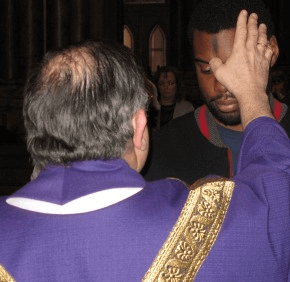By Carol Zimmermann
Catholic News Service
WASHINGTON – In more ways than one, Ash Wednesday – celebrated March 1 this year – leaves a mark.
That’s because not only are Catholics marked with a sign of penitence with ashes on their foreheads, but the rich symbolism of the rite itself draws Catholics to churches in droves even though it is not a holy day of obligation and ashes do not have to be distributed during a Mass.
Almost half of adult Catholics, 45 percent, typically receive ashes – made from the burned and blessed palms of the previous year’s Palm Sunday – at Ash Wednesday services, according to the Center for Applied Research in the Apostolate at Georgetown University.
Parish priests say they get more people at church that day than almost any other – excluding Christmas and Easter – and the congregations are usually much bigger than for Holy Thursday or Good Friday services.
“Virtually every parish that I’ve worked with will have more people come to Ash Wednesday than almost any other celebration,” said Thomas Humphries, assistant professor of philosophy, theology and religion at St. Leo University in St. Leo, Florida.
“We talk about Christmas and Easter as certainly being the most sacred and most attended events during the year, but Ash Wednesday is not even a day of obligation. In terms of liturgical significance, it’s very minor, but people observe it as overwhelmingly important,” he said in a Feb. 17 email to Catholic News Service.
Humphries said part of the Ash Wednesday draw is the “genuine human recognition of the need to repent and the need to be reminded of our own mortality. Having someone put ashes on your head and remind you ‘we are dust and to dust we shall return’ is an act of humility.”
He also said the day – which is the start of Lent in the Latin Church – reminds people that they are not always who they should be and it is a chance to “stand together with people and be reminded of our frailty and brokenness and of our longing to do better.”
“This practice is particularly attractive to us today because it is an embodied way to live out faith, to witness to Christian identity in the world, ” said Timothy O’Malley, director of the Notre Dame Center for Liturgy at the University of Notre Dame, where he also is a professor of New Testament and early Christianity.
He said that’s the only way to explain why millions of people identify themselves “as mortal sinners for an entire day.”
Jesuit Father Bruce Morrill, the Edward A. Malloy professor of Catholic studies at Vanderbilt University Divinity School in Nashville, Tennessee, thinks the appeal of Ash Wednesday is partly because participants receive a “marker of identity” as Catholics.
The day also has rich symbolism, he said, of both flawed humanity and mortality. He pointed out that even though a large percentage of Catholics do not go to confession they will attend this very penitential service because they “get a sense of repentance and a kind of solidarity in it.”
“Clearly it touches on a deep sense of Catholic tradition in a way few other symbols do,” he told CNS Feb. 17.
For many, it also links them to childhood tradition of getting ashes. It also links them, even if they are unaware of its origins, to an ancient church tradition.
The priest said the use of ashes goes back to Old Testament times when sackcloth and ashes were worn as signs of penance. The church incorporated this practice in the eighth century when those who committed grave sins known to the public had to do public penitence, sprinkled with ashes. But by the Middle Ages, the practice of penance and marking of ashes became something for the whole church.
Ash Wednesday also is one of two days, along with Good Friday, that are obligatory days of fasting and abstinence for Catholic adults – meaning no eating meat and eating only one full meal and two smaller meals.
The other key aspect of the day is that it is the start of the 40 days of prayer, fasting and almsgiving of Lent.
“Ash Wednesday can be a little bit like New Year’s Day,” Father Mike Schmitz, chaplain for Newman Catholic Campus Ministries at the University of Minnesota Duluth, told CNS in an email. He said the day gives Catholics “a place to clearly begin something new that we know we need to do.”
Also see:
This Lent, meat OK’d for St. Patrick’s Day in the Archdiocese of Baltimore
Copyright ©2017 Catholic News Service/U.S. Conference of Catholic Bishops.


